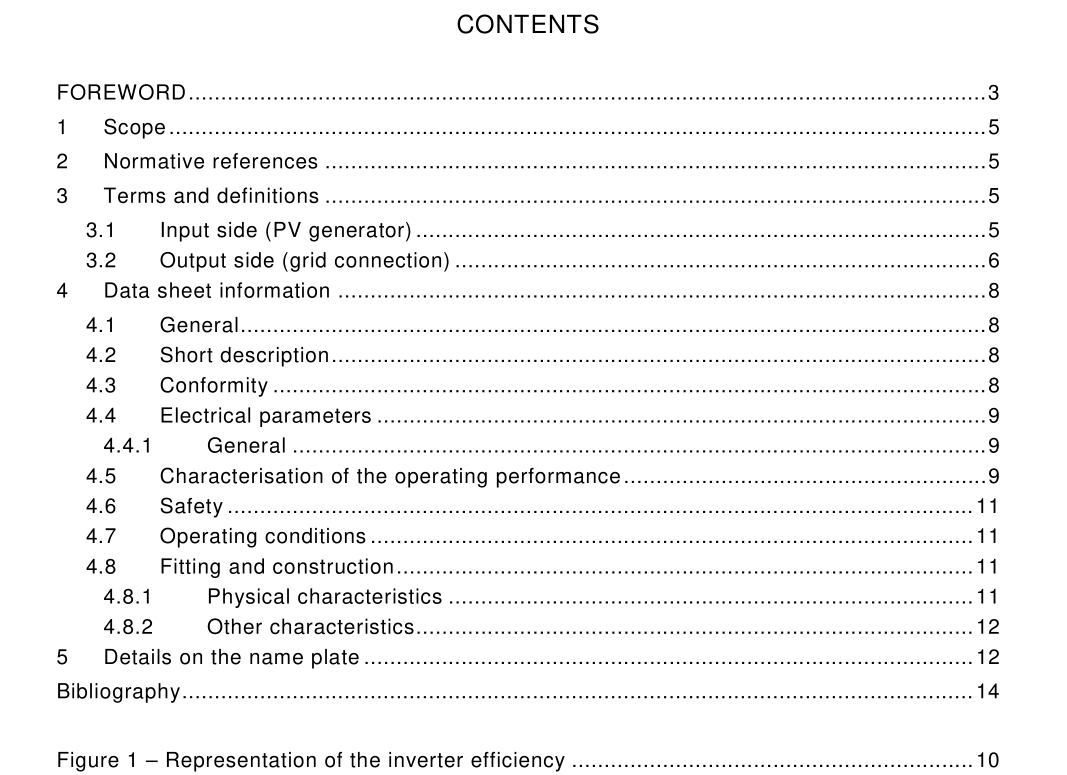IEC 62894 pdf download.Photovoltaic inverters – Data sheet and name plate
1 Scope
This International Standard describes data sheet and name plate information for photovoltaic inverters in grid parallel operation. The object of this standard is to provide minimum information required to configure a safe and optimal system with photovoltaic inverters. In this context, data sheet information is a technical description separate from the photovoltaic inverter. The name plate is a sign of durable construction on or in the photovoltaic inverter. The name plate may be inside the photovoltaic inverter only if the name plate is visible once a door is opened in normal use.
3 Terms and definitions
For the purposes of this document, the following terms and definitions apply. 3.1 Input side (PV generator) 3.1 .1 maximum input voltage V dcmax allowed maximum voltage at the inverter input 3.1 .2 minimum input voltage V dcmin minimum input voltage for the inverter to energize the utility grid, independent of mode of operation 3.1 .3 start-up input voltage V dcstart input voltage at which the inverter starts energizing the utility grid 3.1 .4 rated input voltage V dc,r input voltage specified by the manufacturer, to which other data sheet information refers 3.1 .5 maximum MPP voltage V mppmax maximum voltage at which the inverter can deliver its rated power 3.1 .6 minimum MPP voltage V mppmin minimum voltage at which the inverter can deliver its rated power 3.1 .7 maximum input current I dcmax maximum current at which the inverter can operate. If the inverter has multiple MPP inputs, I dcmax is related to each single input 3.1 .8 maximum short-circuit DC input current I scmax absolute maximum total PV array short circuit current (DC) that the inverter is rated to have connected to its input terminals, under worst-case conditions of ambient temperature, irradiance, etc. Note 1 to entry: This term is based on the term I sc, PV in IEC 621 09-1 . It refers to the absolute maximum current the DC input to the inverter is designed for under conditions of expected use. This differs from the simple sum of the marked I sc ratings of the connected PV modules, since those markings are based on short-circuit conditions under standard test conditions, and may be exceeded in temperatures or irradiance levels different from the standard levels. 3.1 .9 rated input power P dc,r input power (DC) at rated input voltage and rated power (AC) 3.2 Output side (grid connection) 3.2.1 maximum grid voltage V acmax maximum voltage at which the inverter can energize the grid 3.2.2 minimum grid voltage V acmin minimum voltage at which the inverter can energize the grid 3.2.3 rated grid voltage V ac,r utility grid voltage to which other data sheet information refers 3.2.4 maximum output current I acmax maximum output current that the inverter can deliver 3.2.5 rated power P ac,r active power the inverter can deliver in continuous operation 3.2.6 rated frequency f r utility grid frequency at which the inverter performs as specified 3.2.7 maximum frequency f max maximum frequency at which the inverter can energize the grid 3.2.8 minimum frequency f min minimum frequency at which the inverter can energize the grid 3.2.9 night-time power loss power loss of the inverter, which is supplied from the public grid, when no solar generator power is present 3.2.1 0 cosphi ac,r minimum power factor for which the inverter can output the rated active power 3.2.1 1 nominal operation power factor power factor operating at nominal power 3.2.1 2 power factor of operation range range of power factor for the range operation of the inverter
4 Data sheet information
4.1 General Technical products are usually brought into the market with a documentation providing information to the user regarding the operating conditions and its intended purpose. A data sheet specifies a product to the extent that the contained data could be consulted for planning or dimensioning. The size and organization of the data sheet are left to the manufacturer. It is however recommendable to be limited to a double-side printed on A4 sheet, according to ISO 21 6, whereby a topic-specific separation is favourable. The following subclauses define the minimum required information, which should be included on the datasheet for a photovoltaic inverter. Additional information can however be supplied by the manufacturer. 4.2 Short description In short the characteristics of the inverter are to be described. Special characteristics of the inverters can be mentioned. For better identification of the equipment, its photo or its true design drawing should be included on the data sheet. The internal design of the inverter should be represented in a clear way (e.g. by means of a block diagram). The topology type should be indicated too. 4.3 Conformity The conformity to relevant norms and standards shall be shown in the data sheet.
IEC 62894 pdf download
